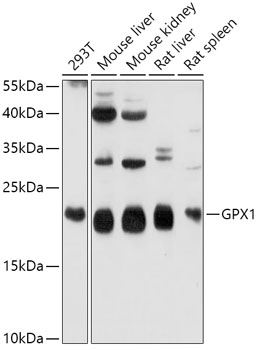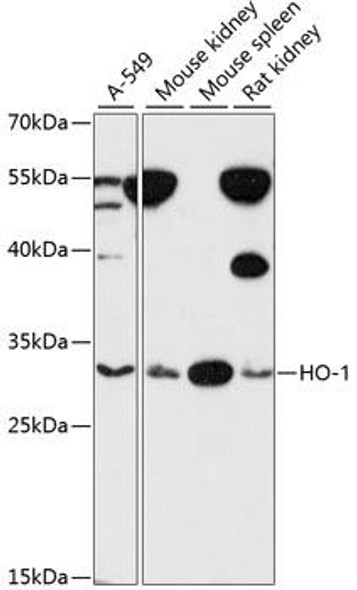| Background: | This gene encodes a member of the glutathione peroxidase family. Glutathione peroxidase functions in the detoxification of hydrogen peroxide, and is one of the most important antioxidant enzymes in humans. This protein is one of only a few proteins known in higher vertebrates to contain selenocysteine, which occurs at the active site of glutathione peroxidase and is coded by UGA, that normally functions as a translation termination codon. In addition, this protein is characterized in a polyalanine sequence polymorphism in the N-terminal region, which includes three alleles with five, six or seven alanine (ALA) repeats in this sequence. The allele with five ALA repeats is significantly associated with breast cancer risk. Two alternatively spliced transcript variants encoding distinct isoforms have been found for this gene. |
| UniProt Protein Function: | Protects the hemoglobin in erythrocytes from oxidative breakdown. |
| NCBI Summary: | The protein encoded by this gene belongs to the glutathione peroxidase family, members of which catalyze the reduction of organic hydroperoxides and hydrogen peroxide (H2O2) by glutathione, and thereby protect cells against oxidative damage. Other studies indicate that H2O2 is also essential for growth-factor mediated signal transduction, mitochondrial function, and maintenance of thiol redox-balance; therefore, by limiting H2O2 accumulation, glutathione peroxidases are also involved in modulating these processes. Several isozymes of this gene family exist in vertebrates, which vary in cellular location and substrate specificity. This isozyme is the most abundant, is ubiquitously expressed and localized in the cytoplasm, and whose preferred substrate is hydrogen peroxide. It is also a selenoprotein, containing the rare amino acid selenocysteine (Sec) at its active site. Sec is encoded by the UGA codon, which normally signals translation termination. The 3' UTRs of selenoprotein mRNAs contain a conserved stem-loop structure, designated the Sec insertion sequence (SECIS) element, that is necessary for the recognition of UGA as a Sec codon, rather than as a stop signal. This gene contains an in-frame GCG trinucleotide repeat in the coding region, and three alleles with 4, 5 or 6 repeats have been found in the human population. The allele with 4 GCG repeats has been significantly associated with breast cancer risk in premenopausal women. Alternatively spliced transcript variants have been found for this gene. Pseudogenes of this locus have been identified on chromosomes X and 21. [provided by RefSeq, Aug 2017] |
| UniProt Code: | P07203 |
| NCBI GenInfo Identifier: | 311033481 |
| NCBI Gene ID: | 2876 |
| NCBI Accession: | P07203.4 |
| UniProt Secondary Accession: | P07203,Q7Z5H1, Q9BW12, E9PAS1, |
| UniProt Related Accession: | P07203 |
| Molecular Weight: | 10,289 Da |
| NCBI Full Name: | Glutathione peroxidase 1 |
| NCBI Synonym Full Names: | glutathione peroxidase 1 |
| NCBI Official Symbol: | GPX1 |
| NCBI Official Synonym Symbols: | GPXD; GSHPX1 |
| NCBI Protein Information: | glutathione peroxidase 1 |
| UniProt Protein Name: | Glutathione peroxidase 1 |
| UniProt Synonym Protein Names: | Cellular glutathione peroxidase |
| Protein Family: | Hydroperoxy fatty acid reductase |
| UniProt Gene Name: | GPX1 |





